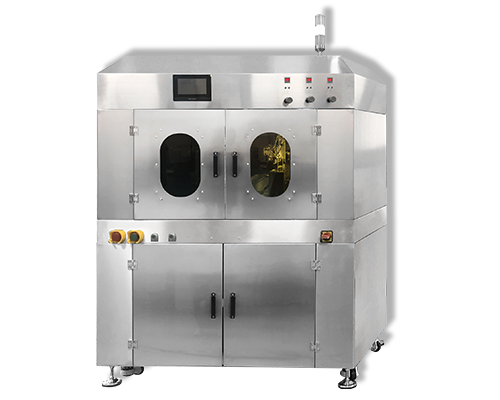Improving Manufacturing Performance of Medical Device Coatings
Improving Manufacturing Performance of Medical Device Coatings – Cheersonic
When manufacturers of disposable medical devices design precision mechanical equipment, friction between moving parts can be difficult to control. Engineers often use medical device coatings such as oils, greases or dry powders to smooth out the fine movements of components. These coatings reduce friction and sticking in sliding, shearing, twisting, shaking or rotating parts. They solve the “sticking” problem commonly found in disposable medical devices such as catheters, cutting tools, staplers, infusion tubing and other “surface-to-surface” components. The lubricating coating reduces the coefficient of friction of the treated parts to 0.06. This typically translates to a 25-30% reduction in driving force, resulting in a significant improvement in component performance. Many of today’s complex medical devices would not be commercially viable without the aid of lubricious coatings.
In addition, lubricious coatings are also used in manufacturing equipment and assembly jigs themselves to help speed up the production of plastic and metal parts. They are used extensively on chains and pulleys, metal extrusions, canopy and door rails, slides and skids, conveyors, and virtually any other surface or component that requires a clean, durable, smooth coating for optimum performance . Lubricant coatings are also used for the release of plastic parts from injection molds.
However, not all lubricious coatings are created equal. Below are some key factors to consider when selecting a lubricious coating for medical device components.
1. Good solubility and low viscosity
Lubricant coating application is usually done by dipping, spraying or wiping. The carrier fluid, or liquid used to disperse the coating, should be designed to dissolve or disperse the coating so that evaporation of the carrier fluid leaves a very thin, uniform coating on the surface of the treated part. It should also have a low viscosity to wet out and conform to the surface geometry of the part being processed, ensuring a highly consistent finish.
2. Inhibit bioburden
Medical device manufacturers should choose lubricious coatings with non-aqueous carrier fluids to prevent bacterial growth and inhibit other biological contamination. In addition to being pyrogenically inert, it should be compatible with all commercially available ethylene oxide (EtO) and radiation disinfection processes.
3. Non-flammable
To reduce the risk of fire when applied, lubricious coatings should be non-flammable—this is especially important in high-volume, high-speed production facilities. Many mechanical assembly operations are prone to static electricity, so non-flammability is critical for safety during storage and use.
4. Good material compatibility
Lubricant coatings should have excellent material compatibility. They should be safe to coat on a variety of materials including metal, glass, plastic and ceramic parts.
5. Easy to coat
Lubricant coatings should be easy to apply for use during internal assembly. By completing the coating process in-house, equipment manufacturers can monitor and process parts throughout, saving time and money by validating the process.
6. Quick drying and low odor
Medical device manufacturers should seek a coating that employs a carrier fluid that evaporates quickly, has low odor and leaves no residue other than the coating deposited on the substrate.
7. Durable and beautiful
A good coating dries to a surface that will extend the life of your equipment. It should maintain an even and smooth appearance without any blotches or unsightly lumps, drips or runs.
8. No Migration
Coatings should not migrate or transfer to packaging or other untreated surfaces. Lubricant coatings should remain on the area to which they are applied. This property is an essential attribute when the coating is applied in a clean room environment.
9. Safe for workers and the environment
Equipment manufacturers should select lubricating coatings with higher worker exposure limits. Please select products with an 8 hour time weighted average of 200ppm or above.
10. Medical grade
Make sure the coating is ISO 10993 tested and certified as medical grade and should also be clean room compatible. This helps ensure a faster and easier validation process for coatings and related equipment.
Manufacturers of disposable medical devices have a variety of lubricious coating options available. When specifying coatings, manufacturers should look for a supplier who can provide expert advice to help them simplify the screening process. Such services include individualized consultation, laboratory testing, and standard and custom formulation capabilities to ensure the correct coating for a manufacturer’s specific needs.
UAM7000-M Ultrasonic Drug Balloon Coating Machine is designed for drug eluting balloons. It provides a uniform drug coating for the balloon catheter through ultrasonic spray technology. UAM7000-M can also be used to adjust and control the deposition process of drug coatings for different liquid formulations. With the help of a special fixing device design, the entire balloon catheter can be sprayed with a maximum spraying length of 280 mm., It also has the functions of solvent doping, pre-heating, humidity control, and drying. The equipment has the characteristics of precise application amount, uniform film layer, and high utilization rate of chemical liquid. Cheersonic has extensive experience in surface coating of implantable medical devices (such as drug stents and balloons), and can provide customers with complete solutions.
Chinese Website: Cheersonic Provides Professional Coating Solutions


